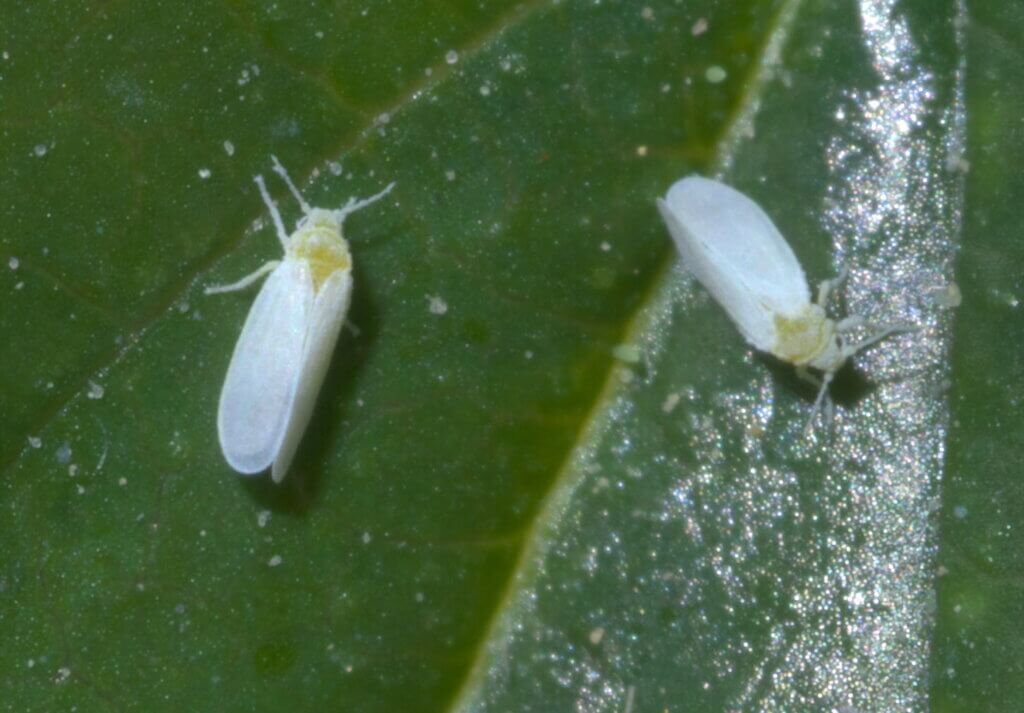Whiteflies are a common and troublesome pest in South African gardens, affecting a wide variety of plants, including vegetables, ornamentals, and fruit trees. These tiny insects can multiply rapidly, leading to significant plant damage if not managed promptly. In this comprehensive guide, we’ll help you identify, treat, and prevent whitefly infestations, ensuring that your plants remain healthy and vibrant.
Identifying Whiteflies and Infestations
These tiny, white, moth-like insects gather on the undersides of leaves, where they feed on plant sap. Although they are small, their effects can be devastating, especially in warm, sheltered environments like greenhouses, or in the home around houseplants.
How to Recognize Whiteflies:
- Appearance: Adult whiteflies are tiny, white insects with powdery wings. They resemble miniature moths and are often seen in groups.
- Feeding signs: Whiteflies feed on plant sap, leading to yellowing or curling leaves. Infested plants may appear weakened or stunted in growth.
- Honeydew and Sooty Mold: Whiteflies excrete a sticky substance known as honeydew. This attracts ants and encourages the growth of sooty mold, a black fungus that covers leaves, inhibiting photosynthesis and further weakening the plant.
- Flying Behavior: When disturbed, whiteflies fly up in clouds from the plant’s foliage, making them easy to spot once an infestation has taken hold.
The Impact of Whiteflies on Plants and Gardens
Whiteflies are a serious threat to both outdoor and indoor plants, particularly in the warm climate of South Africa. If left unchecked, they can cause widespread damage, especially in areas like the Western Cape, KwaZulu-Natal, and Gauteng, where temperatures and humidity create ideal breeding conditions for these pests.
Why Whiteflies are Harmful:
- Sap-Sucking Damage: By sucking out the plant’s nutrients, whiteflies weaken plants, causing leaf yellowing, wilting, and reduced growth.
- Virus Transmission: Whiteflies can spread plant viruses, which can severely impact crops like tomatoes, beans, and cucumbers, leading to lower yields.
- Secondary Infections: The honeydew they produce can lead to sooty mold, further stressing plants and reducing photosynthesis.
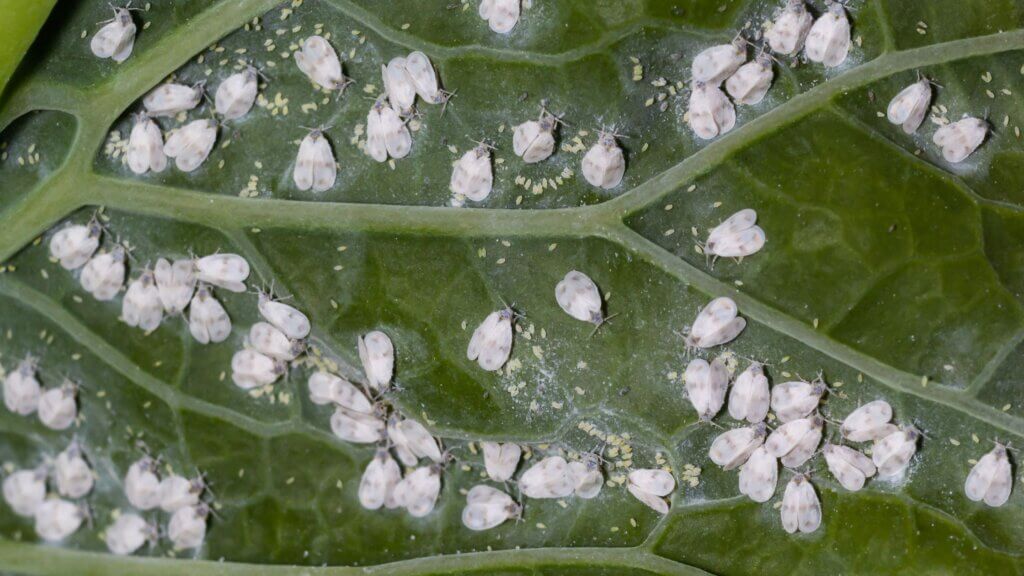
How to Get Rid of Whiteflies: Effective Treatment Options
When dealing with whiteflies, it’s important to act swiftly to prevent them from spreading to other plants. Below are various methods, both chemical and organic, to help you control whitefly populations.
Chemical Solutions to Get Rid of Whiteflies
For gardeners facing severe infestations, chemical treatments are often the quickest and most effective option. South African gardeners have access to a variety of insecticides that control whiteflies.
Top Chemical Products for Whitefly Control:
- ProTek Complete 350 SC is a powerful insecticide designed to combat whitefly infestations across a range of crops, including fruits, vegetables, and ornamentals. Its unique formulation provides both contact and systemic action, ensuring effective control of whiteflies by targeting both adult insects and larvae. With long-lasting residual protection, ProTek Complete 350 SC penetrates plant tissues, offering extended defense even after the initial application. This product is suitable for integrated pest management programs, giving your garden or farm robust protection against whiteflies and other pests.
- Makhro Home and Garden Plant Care offers an efficient and user-friendly solution to manage whitefly infestations on a variety of plants, including fruits, vegetables, flowers, and ornamentals. This product provides both contact and systemic protection, effectively targeting whiteflies at all life stages, from eggs to adults. Makhro Plant Care works by absorbing into plant tissues, offering long-lasting defense against whiteflies while being safe for use in home gardens. It’s ideal for gardeners looking for a reliable, easy-to-apply treatment that ensures healthy, thriving plants.
- Kombat Garden Insects provides an effective solution for managing whitefly infestations in home gardens. This versatile insecticide, containing Deltamethrin as its active ingredient, offers both stomach and contact action, ensuring fast and reliable control of whiteflies and other common pests. Kombat Garden Insects is easy to mix and can be applied as a spray on foliage or soil, delivering quick action with long-lasting residual effects. It’s ideal for home gardeners looking to protect a wide range of plants, from flowers to vegetables, against persistent whitefly problems.
How to Apply Chemical Insecticides:
- Thorough Coverage: Ensure you spray both the upper and lower sides of leaves, as whiteflies typically hide underneath.
- Timing: For best results, apply in the early morning or late afternoon when temperatures are cooler and whiteflies are less active.
- Follow Instructions: Always follow the manufacturer’s directions to ensure effective and safe use.
Natural and Organic Whitefly Control Solutions
For gardeners looking for eco-friendly options, there are several natural remedies that are highly effective in managing whiteflies. These methods are particularly suited for vegetable gardens, fruit trees, and areas where children and pets are present.
Popular Organic Whitefly Control Products:
- Makhro Organicide is a powerful, eco-friendly solution for whitefly control, designed to protect your roses, fruit trees, vegetables, and ornamentals. With its organic broad-spectrum insecticide concentrate, Makhro Organicide combines contact action and repelling properties, effectively targeting whiteflies, aphids, and red spider mites. Formulated with Canola oil, Garlic extract, and Pyrethrum, this insecticide ensures comprehensive protection while being safe for both your plants and the environment.
- Kirchhoff’s Margaret Roberts Organic Insecticide is a trusted, eco-friendly solution for controlling whiteflies and other common garden pests. Its active ingredients include Canola oil, which suffocates small-bodied insects like whiteflies on contact, and Garlic extract, a natural repellent that helps keep pests away. This organic insecticide is safe to use on a variety of crops, including herbs, vegetables, fruits, salads, roses, and ornamentals. Ideal for home gardens, Margaret Roberts Organic Insecticide provides quick action with harvesting allowed within 24 hours of the last application, making it a safe and effective choice for gardeners looking to protect their plants naturally.
- Kirchhoff’s Ludwig’s Insect Spray: Ludwig’s Insect Spray offers an effective organic solution for treating whitefly infestations on fruit, vegetables, roses, ornamentals, and more. Its active ingredients include Canola oil, which suffocates small-bodied insects on contact, Garlic extract, a natural repellent, and Pyrethrins, derived from Chrysanthemum flowers, which provide residual action for up to 24 hours, killing larger insects. Safe for edible crops, with harvesting allowed just 24 hours after application. Available in various sizes, it’s a natural choice for protecting your garden.
- Biogrow Bioneem, offers a natural, organic solution for managing whiteflies and other garden pests. Derived from the neem tree, its active ingredient Azadirachtin disrupts the feeding and molting process of over 200 insect types, including whiteflies, without harming beneficial pollinators like bees, butterflies, and ladybugs. Suitable for use on a wide range of plants, Bioneem provides long-lasting protection, with residual effects lasting up to 7 days.
Other Organic Methods to Get Rid of Whiteflies:
- Neem Oil: A natural insecticide, neem oil disrupts the feeding and reproduction cycles of whiteflies, reducing their population over time. It’s safe for most plants and doesn’t harm beneficial insects.
- Insecticidal Soap: This soap suffocates whiteflies by breaking down their outer coating. It’s safe for use on vegetables, ornamentals, and fruit trees.
- Beneficial Insects: Introducing natural predators like ladybugs, lacewings, and parasitic wasps into your garden can help control whitefly populations by feeding on the pests and their larvae.
Plants Vulnerable to Whiteflies
Whiteflies can infest a wide range of plants, particularly those with soft leaves or vigorous growth. Understanding which plants are more susceptible will help you focus on regular inspections and early intervention.
Plants Commonly Affected by Whiteflies:
- Tomatoes (Solanum lycopersicum): Whiteflies are notorious for attacking tomatoes, causing stunted growth and fruit damage.
- Roses (Rosa spp.): These beloved garden plants are often targeted, leading to yellowing leaves and reduced flower production.
- Cucumbers (Cucumis sativus): Cucumber plants are particularly prone to whitefly infestations, especially in warm conditions.
- Beans (Phaseolus spp.): Whiteflies can damage both the leaves and pods, leading to reduced yields.
- Ornamentals: Many flowering plants, such as fuchsias and geraniums, are susceptible to whitefly damage.
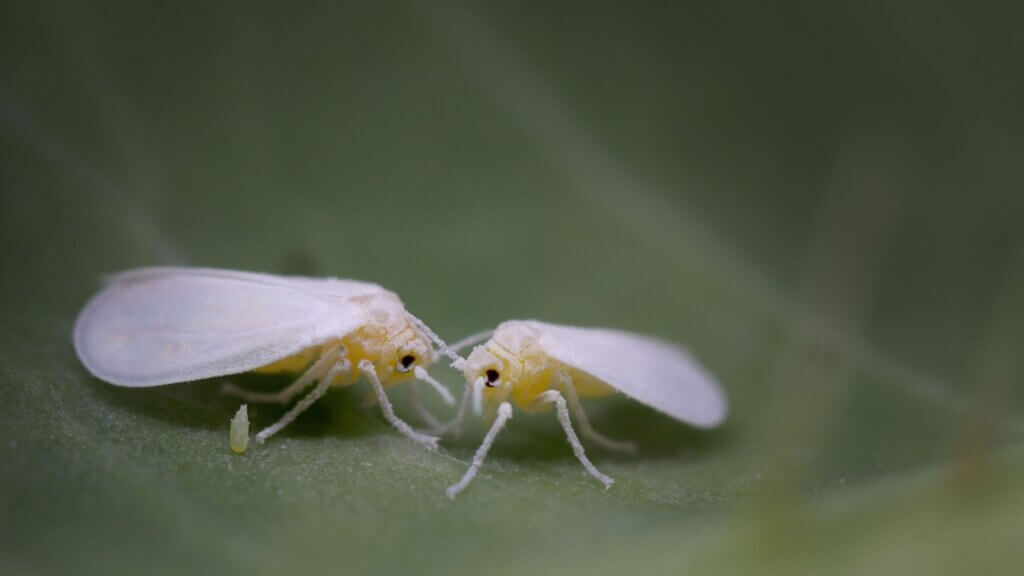
Preventing Whiteflies in Your South African Garden
Prevention is the most effective approach to managing whiteflies in your garden. These pests are small but can cause significant damage if allowed to reproduce unchecked. By taking proactive steps, you can reduce the likelihood of infestations and keep your plants healthy throughout the year. South Africa’s warm climate, particularly in regions like the Western Cape, Gauteng, and KwaZulu-Natal, provides an ideal breeding ground for whiteflies, so it’s essential to be vigilant.
Tips for Preventing Whiteflies
Regular Plant Inspections
- Why it’s important: Whiteflies often start infesting plants in small numbers, and by the time you notice their damage, their population may have already exploded. Inspecting your plants frequently, especially the undersides of the leaves, will allow you to catch them early.
- What to look for: Pay attention to small white insects flying up when the plant is disturbed, or look for sticky honeydew on the leaves, which is a sign of whitefly feeding. The presence of black sooty mold also indicates a potential whitefly problem.
- When to inspect: Increase the frequency of inspections during warmer months, as whiteflies are more active in higher temperatures, particularly in summer and late spring.
Maintain Plant Health
- Why it’s important: Strong, healthy plants are less susceptible to pests like whiteflies. Well-maintained plants are better able to withstand minor infestations and recover quickly from pest damage.
- How to maintain health: Ensure your plants receive adequate water, proper nutrients, and regular care. Over-fertilizing can attract whiteflies, so avoid excessive nitrogen-rich fertilizers, as they promote soft, new growth that is particularly appealing to whiteflies.
- Boosting resistance: Use organic compost and natural fertilizers to promote soil health, as healthier soil helps plants develop stronger natural defenses.
Use Yellow Sticky Traps
- How they work: Whiteflies are attracted to the color yellow, which mimics the reflective surfaces of plant leaves. By placing yellow sticky traps near vulnerable plants, you can catch adult whiteflies before they have the chance to lay eggs.
- Placement tips: Hang traps around plants that are prone to infestations, such as tomatoes, cucumbers, and roses. Replace the traps regularly to keep them effective.
- Additional benefits: Yellow sticky traps are also useful for monitoring whitefly populations in your garden. Even if you don’t notice a large number of whiteflies, catching a few early can prompt you to take preventive measures.
Prune Dense Foliage
- Why it’s important: Whiteflies prefer dense, shady environments where there is less air circulation. By pruning plants and removing excess foliage, you increase airflow and sunlight penetration, making the environment less conducive for whitefly breeding.
- How to prune: Trim back overgrown branches and foliage, especially on plants like roses and fuchsias, which are susceptible to whitefly infestations. Regular pruning not only reduces pest habitats but also encourages healthy plant growth.
- Tip: When pruning, dispose of the cuttings away from your garden or compost them properly to avoid reintroducing pests.
Companion Planting
- How it works: Companion planting involves growing certain plants alongside vulnerable crops to repel whiteflies naturally. Some plants emit strong odors or produce chemicals that deter whiteflies.
- Effective companion plants: Consider planting marigolds, nasturtiums, basil, or garlic near your vegetables or flowers. These plants can help keep whiteflies away while also attracting beneficial insects like ladybugs, which prey on whiteflies.
- Designing your garden: Mix companion plants among your crops, especially near tomatoes, cucumbers, and beans, which are often targeted by whiteflies. This practice helps create a natural defense system against pests.
Step-by-Step Guide to Treating Whitefly Infestations
If you discover whiteflies in your garden despite your preventive efforts, prompt action is essential to prevent the infestation from spreading. Below is a detailed step-by-step guide to managing whiteflies once an infestation is detected.
Step 1: Identification
- Inspect your plants thoroughly: Whiteflies tend to gather on the undersides of leaves, laying eggs and feeding on the plant sap. Look for tiny white insects that fly up when you disturb the plant, and check for signs like yellowing leaves, sticky honeydew, and black sooty mold.
- Use a magnifying glass: Whitefly eggs and larvae can be hard to spot with the naked eye. A magnifying glass will help you confirm the presence of whiteflies and determine the severity of the infestation.
Step 2: Isolation
- Isolate infested plants: If possible, move heavily infested plants away from the healthy ones to prevent whiteflies from spreading throughout your garden. This is especially important for potted plants, which can be relocated to a quarantine area.
- Physical barriers: For large plants that cannot be moved, consider using garden fleece or netting to prevent whiteflies from flying to other plants.
Step 3: Pruning
- Remove heavily infested leaves: Pruning infested leaves will reduce the whitefly population quickly by removing eggs, larvae, and adult insects from the plant. This is particularly effective if only a few plants are affected.
- Dispose of infested material properly: Place pruned leaves in a sealed bag and dispose of them away from your garden to avoid reintroducing the whiteflies. Avoid composting infected leaves, as eggs can hatch and reinfest the garden.
Step 4: Treatment
- Chemical treatment: For severe infestations, apply a chemical insecticides such as those mentioned above. Follow the instructions carefully, ensuring thorough coverage of both the upper and lower sides of the leaves.
- Organic options: For a more environmentally friendly approach, use organic Insecticides such as those mentioned above. These products are safe for beneficial insects and can be used on edible crops.
- Homemade remedies: A simple mixture of water, dish soap, and neem oil can also help control whiteflies. Spray the solution directly on affected plants, focusing on the undersides of the leaves.
Step 5: Reapplication
- Reapply treatments as needed: Whitefly eggs hatch in cycles, so you may need to reapply treatments several times to ensure all stages of the whitefly lifecycle are eradicated. Reapply chemical or organic sprays every 7-10 days or as recommended on the product label.
- After rainfall: Rain can wash away treatments, so reapply after heavy rainfall to maintain effectiveness.
Step 6: Ongoing Monitoring
- Regular inspections: Even after treatment, continue to inspect your plants regularly for any signs of a whitefly resurgence. If you catch them early, it will be easier to manage future outbreaks.
- Trap monitoring: Keep using yellow sticky traps in your garden to monitor the presence of adult whiteflies. If you see increasing numbers, it might be time to reapply treatments.
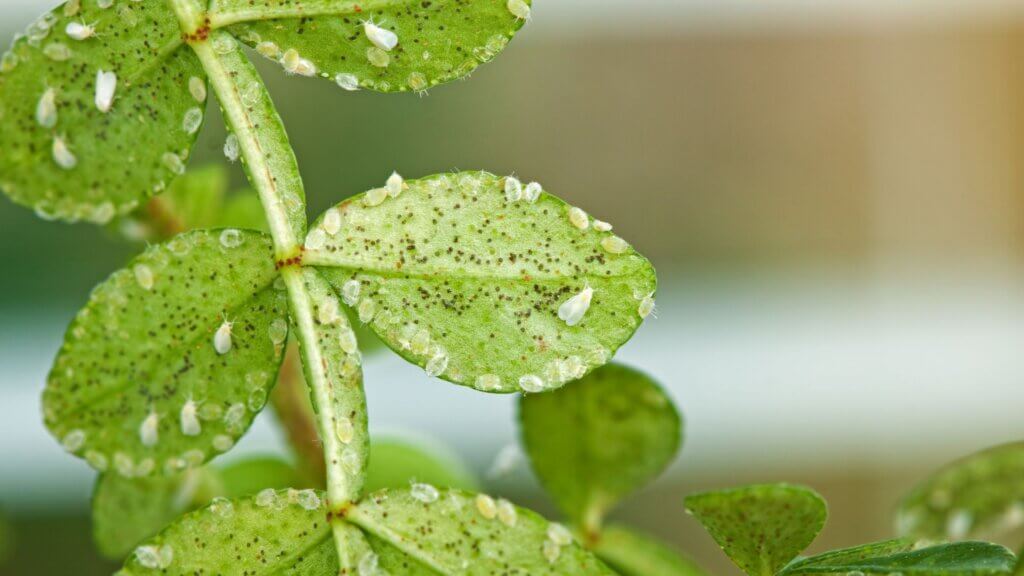
Common Questions and Answers on How to Get Rid of Whiteflies
How do you get rid of whiteflies?
To get rid of whiteflies, start by identifying the infestation and isolating heavily infested plants. Prune off affected leaves and apply either chemical insecticides or organic treatments such as neem oil or insecticidal soaps. Reapply treatments every 7-10 days to target eggs and larvae. Yellow sticky traps can also help catch adult whiteflies. Consistent monitoring and reapplication are key to controlling and eradicating the pest.
What is a natural killer for whiteflies?
Neem oil is a highly effective natural solution for killing whiteflies. It disrupts their feeding and reproduction cycles, helping to reduce their population. Other natural killers include insecticidal soaps, horticultural oils, and beneficial insects like ladybugs and parasitic wasps that prey on whiteflies and their larvae.
What is the best spray for whiteflies?
The best sprays for whiteflies depend on the severity of the infestation. For chemical control, Protek Imidacloprid 350 SC and Kombat Garden Insects offer effective results. For organic options, Makhro Organicide and Kirchhoff’s Margaret Roberts Organic Insecticide provide excellent control while being safe for edible crops and beneficial insects. Insecticidal soaps and neem oil sprays are also great organic choices.
What are the problems with whitefly?
Whiteflies cause multiple issues in gardens, including:
- Sap-Sucking Damage: Whiteflies weaken plants by feeding on their sap, causing yellowing and wilting of leaves.
- Virus Transmission: They can transmit plant viruses, leading to reduced crop yields.
- Sooty Mold Growth: Their excretion of honeydew promotes the growth of black sooty mold, which blocks photosynthesis and further stresses plants.
What attracts whiteflies?
Whiteflies are attracted to plants with soft, vigorous growth, particularly those that are over-fertilized with nitrogen. They are also drawn to the undersides of leaves where they can feed and lay eggs. Warm, sheltered environments like greenhouses or gardens with dense foliage provide ideal conditions for whitefly infestations.
What is a homemade solution for whiteflies?
A simple and effective homemade solution for whiteflies is a mixture of dish soap and water. Mix about 1-2 tablespoons of dish soap with 1 liter of water and spray it directly on the affected plants. This solution suffocates whiteflies by breaking down their protective outer layer. Neem oil can also be added to the mix for extra effectiveness.
Does vinegar get rid of whiteflies?
Vinegar can be used as a mild deterrent for whiteflies, but it is not the most effective solution. Vinegar sprays can harm plants if applied in high concentrations, so it’s better to use more plant-friendly options like neem oil or insecticidal soap. If using vinegar, dilute it heavily (1 part vinegar to 10 parts water) and test it on a small area first.
What are the natural enemies of whiteflies?
Natural predators of whiteflies include:
- Ladybugs: Feed on whitefly larvae and eggs.
- Lacewings: Eat both adult whiteflies and larvae.
- Parasitic Wasps: Lay eggs inside whitefly larvae, effectively controlling their population.
- Predatory Mites: Consume whitefly eggs and young nymphs. Introducing these beneficial insects into your garden can help reduce whitefly populations naturally.
Does washing up liquid get rid of whitefly?
Yes, washing-up liquid mixed with water can help control whiteflies. When sprayed on the plant, the soapy solution suffocates the whiteflies by disrupting their waxy protective coating. Be sure to use a mild soap and not to overapply, as strong detergents may damage plants.
How to make soap spray for whiteflies?
To make a soap spray, mix:
- 1-2 tablespoons of dish soap or castile soap with
- 1 liter of water. Shake well and spray directly on the infested plants, focusing on the undersides of the leaves where whiteflies typically hide. Reapply the spray every few days to control the population.
How do you make garlic spray for whiteflies?
Garlic spray is an effective natural repellent for whiteflies. To make it:
- Crush 2-3 garlic cloves and soak them in 1 liter of water for 24 hours.
- Strain the mixture and add a tablespoon of dish soap to help the solution stick to the plant leaves.
- Pour the mixture into a spray bottle and apply it to the affected plants, particularly the undersides of the leaves. Reapply the spray weekly or after rain to keep whiteflies at bay.
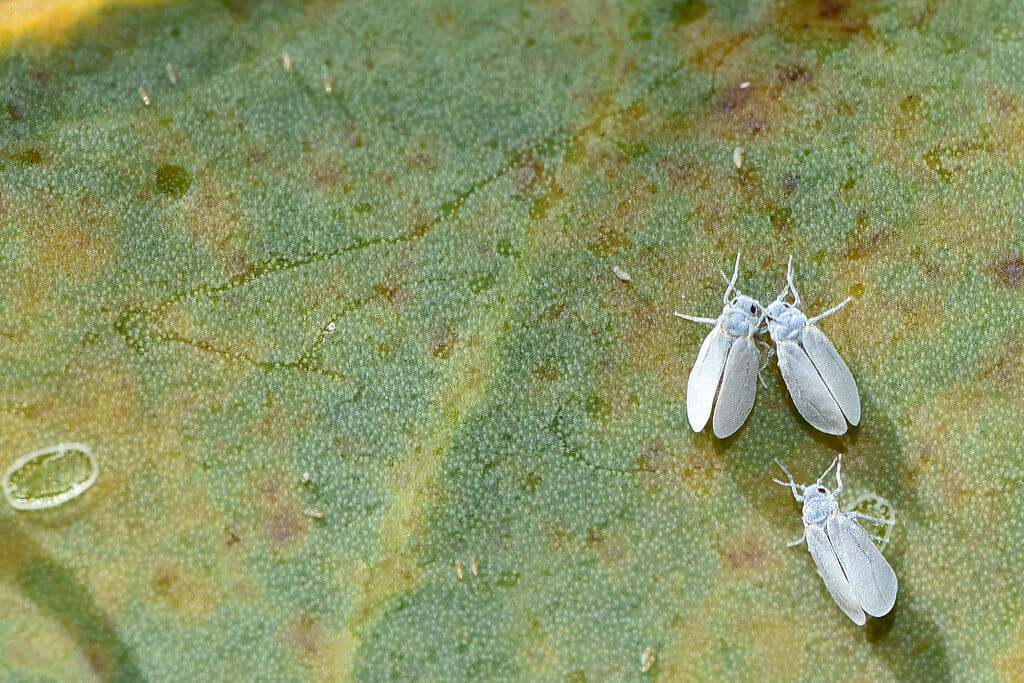
Top Tips for Controlling and Preventing Whiteflies
- Inspect Regularly: Frequently check the undersides of leaves, especially during warmer months, to catch whiteflies early.
- Use Yellow Sticky Traps: Place these traps around vulnerable plants to catch adult whiteflies before they can lay eggs.
- Prune Dense Foliage: Thin out overgrown plants to improve air circulation and reduce the habitat for whiteflies.
- Maintain Plant Health: Healthy, well-nourished plants are more resistant to whitefly infestations. Avoid over-fertilizing with nitrogen, which attracts these pests.
- Utilize Companion Plants: Grow plants like marigolds, nasturtiums, or basil to naturally repel whiteflies.
- Natural Enemies: Introduce beneficial insects such as ladybugs, lacewings, and parasitic wasps to control whitefly populations naturally.
- Reapply Treatments: Whether using chemical or organic sprays, reapply as needed, especially after rain or watering, to ensure continued protection.
Conclusion
Whiteflies can be a persistent challenge in South African gardens, but with the right approach, they can be effectively controlled. Regular inspections, combined with proactive measures such as pruning, companion planting, and using yellow sticky traps, will help you stay ahead of infestations.

